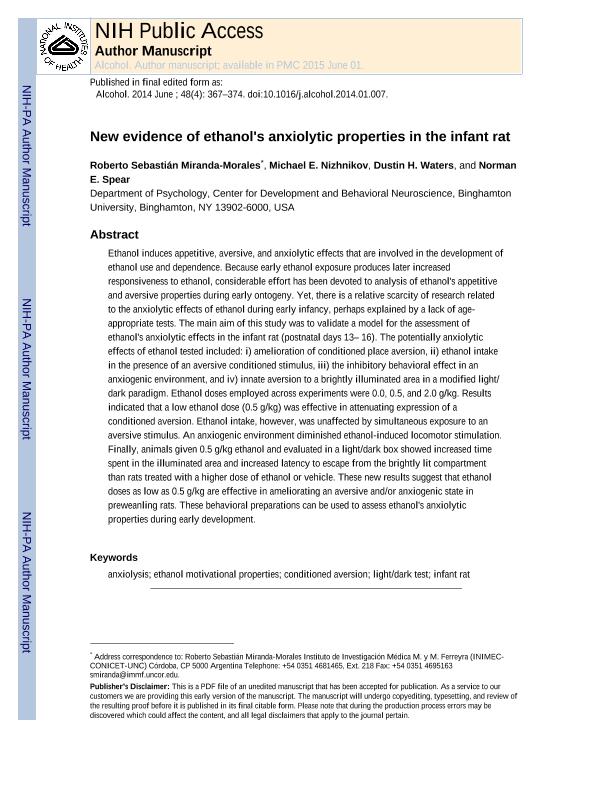Mostrar el registro sencillo del ítem
dc.contributor.author
Miranda Morales, Roberto Sebastián

dc.contributor.author
Nizhnikov, Michael E.
dc.contributor.author
Waters, Dustin H.
dc.contributor.author
Spear, Norman
dc.date.available
2017-12-27T15:19:22Z
dc.date.issued
2014-06
dc.identifier.citation
Miranda Morales, Roberto Sebastián; Nizhnikov, Michael E.; Waters, Dustin H.; Spear, Norman; New evidence of ethanol's anxiolytic properties in the infant rat; Elsevier Science Inc; Alcohol; 48; 4; 6-2014; 367-374
dc.identifier.issn
0741-8329
dc.identifier.uri
http://hdl.handle.net/11336/31639
dc.description.abstract
Ethanol induces appetitive, aversive, and anxiolytic effects that are involved in the development ofethanol use and dependence. Because early ethanol exposure produces later increased responsiveness toethanol, considerable effort has been devoted to analysis of ethanol’s appetitive and aversive propertiesduring early ontogeny. Yet, there is a relative scarcity of research related to the anxiolytic effects ofethanol during early infancy, perhaps explained by a lack of age-appropriate tests. The main aim of thisstudy was to validate a model for the assessment of ethanol’s anxiolytic effects in the infant rat (postnataldays 13e16). The potentially anxiolytic effects of ethanol tested included: i) amelioration of conditionedplace aversion, ii) ethanol intake in the presence of an aversive conditioned stimulus, iii) the inhibitorybehavioral effect in an anxiogenic environment, and iv) innate aversion to a brightly illuminated area in amodified light/dark paradigm. Ethanol doses employed across experiments were 0.0, 0.5, and 2.0 g/kg.Results indicated that a low ethanol dose (0.5 g/kg) was effective in attenuating expression of a condi-tioned aversion. Ethanol intake, however, was unaffected by simultaneous exposure to an aversivestimulus. An anxiogenic environment diminished ethanol-induced locomotor stimulation. Finally, ani-mals given 0.5 g/kg ethanol and evaluated in a light/dark box showed increased time spent in the illu-minated area and increased latency to escape from the brightly lit compartment than rats treated with ahigher dose of ethanol or vehicle. These new results suggest that ethanol doses as low as 0.5 g/kg areeffective in ameliorating an aversive and/or anxiogenic state in preweanling rats. These behavioralpreparations can be used to assess ethanol’s anxiolytic properties during early development.
dc.format
application/pdf
dc.language.iso
eng
dc.publisher
Elsevier Science Inc

dc.rights
info:eu-repo/semantics/openAccess
dc.rights.uri
https://creativecommons.org/licenses/by-nc-sa/2.5/ar/
dc.subject
Anxiolysis
dc.subject
Ethanol Motivational Properties
dc.subject
Conditioned Aversion
dc.subject
Light/Dark Test
dc.subject
Infant Rat
dc.subject.classification
Inmunología

dc.subject.classification
Medicina Básica

dc.subject.classification
CIENCIAS MÉDICAS Y DE LA SALUD

dc.title
New evidence of ethanol's anxiolytic properties in the infant rat
dc.type
info:eu-repo/semantics/article
dc.type
info:ar-repo/semantics/artículo
dc.type
info:eu-repo/semantics/publishedVersion
dc.date.updated
2017-12-26T20:37:14Z
dc.journal.volume
48
dc.journal.number
4
dc.journal.pagination
367-374
dc.journal.pais
Estados Unidos

dc.journal.ciudad
New York
dc.description.fil
Fil: Miranda Morales, Roberto Sebastián. University Of Binghamton; Estados Unidos. Consejo Nacional de Investigaciones Científicas y Técnicas; Argentina
dc.description.fil
Fil: Nizhnikov, Michael E.. University Of Binghamton; Estados Unidos
dc.description.fil
Fil: Waters, Dustin H.. University Of Binghamton; Estados Unidos
dc.description.fil
Fil: Spear, Norman. University Of Binghamton; Estados Unidos
dc.journal.title
Alcohol

dc.relation.alternativeid
info:eu-repo/semantics/altIdentifier/doi/http://dx.doi.org/10.1016/j.alcohol.2014.01.007
dc.relation.alternativeid
info:eu-repo/semantics/altIdentifier/url/http://www.sciencedirect.com/science/article/pii/S0741832914000706
dc.relation.alternativeid
info:eu-repo/semantics/altIdentifier/url/https://www.ncbi.nlm.nih.gov/pmc/articles/PMC4035812/
Archivos asociados
